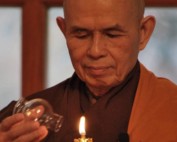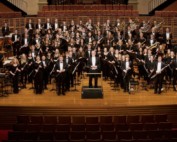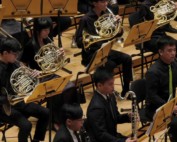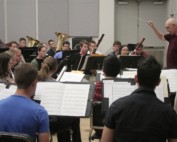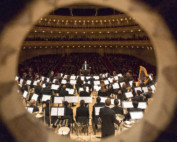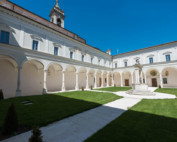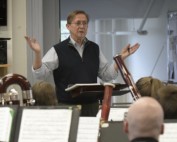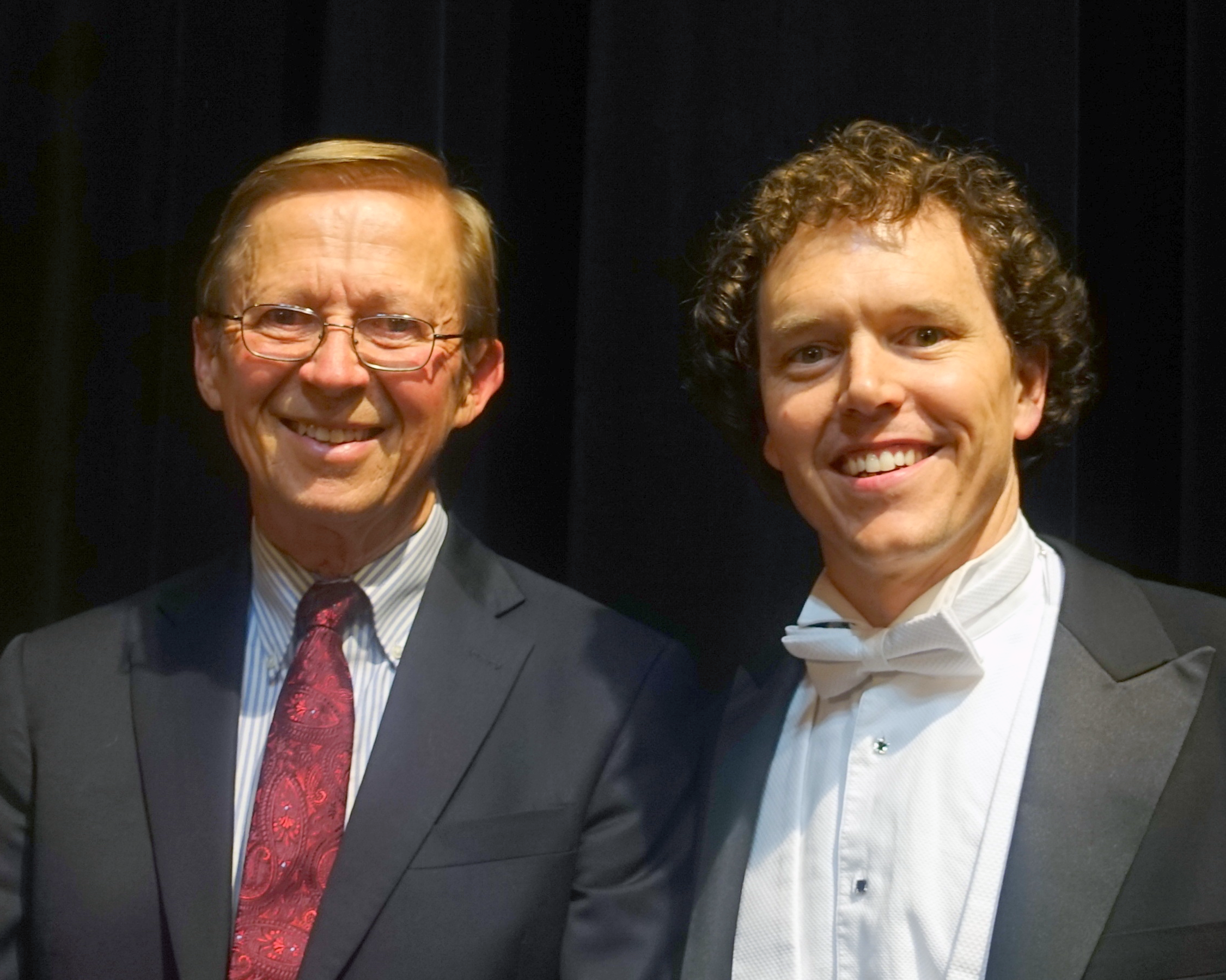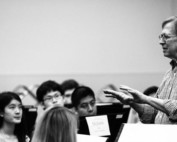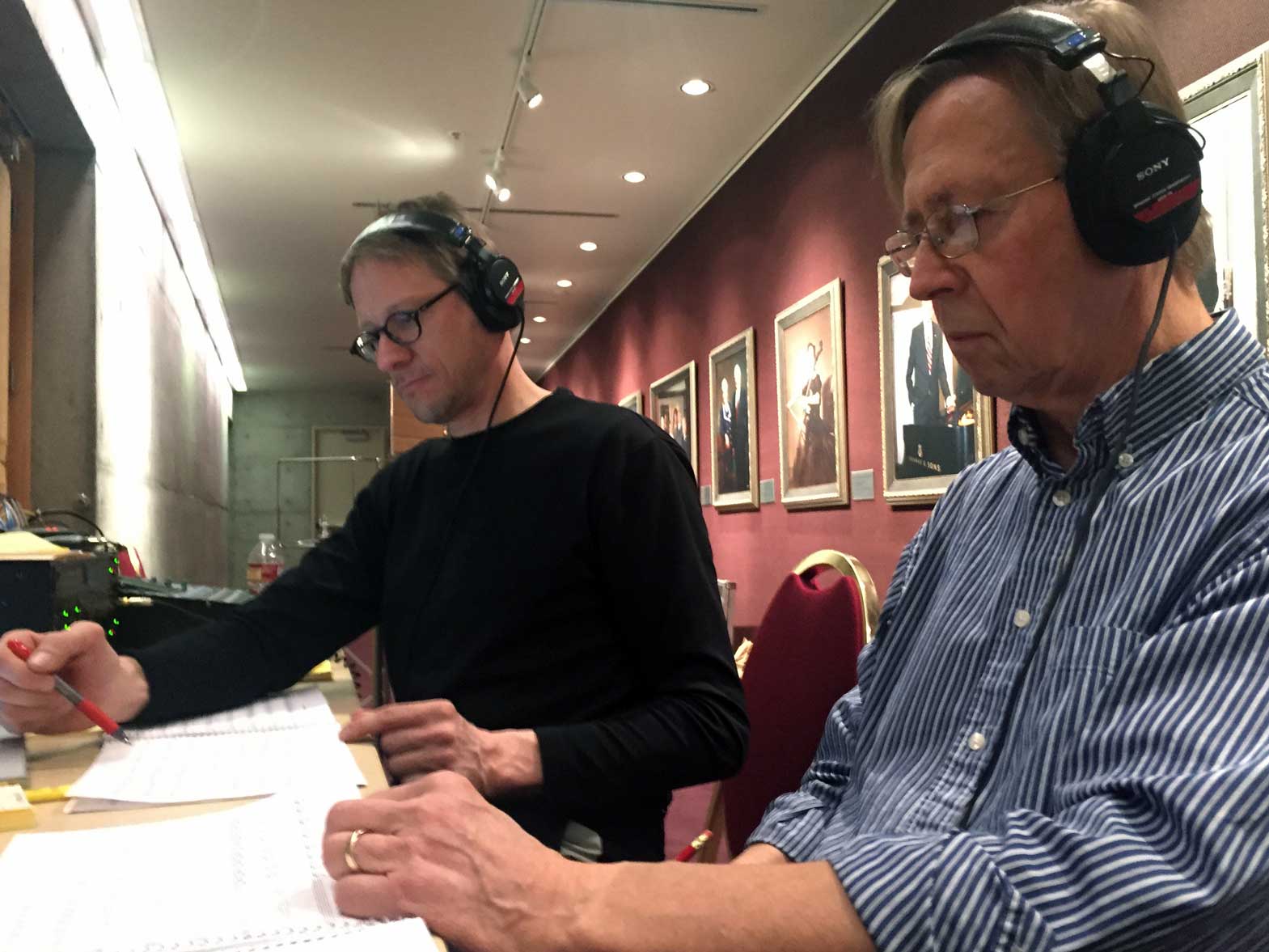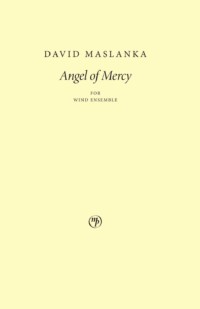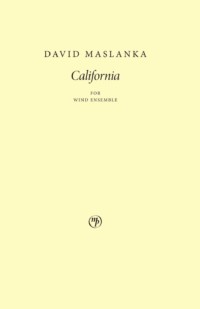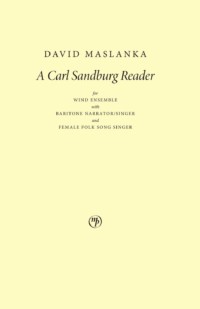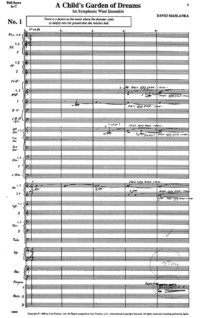Project Description
Wind Ensemble
2006
10 min.
Listen Now
University of Illinois, Stephen Steele, cond.
On the album David Maslanka: Unending Stream of Life (2009)
Instrumentation
- Piccolo
- Flute (2)
- Oboe (2)
- Clarinet in B♭ (3)
- Bass Clarinet in B♭
- Contra-alto Clarinet in E♭
- Bassoon
- Alto Saxophone (2)
- Tenor Saxophone
- Baritone Saxophone
- Horn in F (4)
- Trumpet in B♭ (2)
- Trombone (3)
- Euphonium
- Tuba
- Double Bass
- Piano
- Timpani
- Required Percussion (4 players)
- Bass Drum
- Bell (brass cup, sm.)
- Cabasa
- Castanets
- Claves
- Hand Bells
- Marimba
- Orchestra Bells
- Snare Drum
- Suspended Cymbal
- Tam-tam
- Tambourine
- Temple Blocks
- Tom (med)
- Tom-toms
- Vibraphone (2)
- Wind Chimes (metal)
- Xylophone
Commissioned by
- University of Arizona – Gregg I. Hanson
- California State University Fresno – Gary P. Gilroy
- California State University Fullerton – Mitch Fennell
- Illinois State University – Stephen K. Steele
- California State University Los Angeles – Abel Ramirez
- Sonoma State University – Brian Wilson
- Canyon Crest Academy High School, California – Any Villanova
- Central High School, Champaign, Illinois – John Currey
- Central High School, LaCrosse, Wisconsin – Christopher Werner
- Diamond Bar High School, California – Rick Lorenz
- Green Valley High School, Nevada – Diane Koutsulis
- Grossmont High School, California – John Borodach
- Helix Charter High School – Matt Quiroz
Premiere
Official premiere: 17 February 2006, 9:30 a.m. at the 2006 California Band Directors Association convention, salon A at the Radisson Hotel in Fresno, CA.
Both performances by the Rancho Buena Vista High School Wind Ensemble, Eric Weirather, cond.
Errata
Clarinet 3: movement 2, m. 263 beat 3-264 beat 1. G3 concert (A3 written), not C3 concert (D3 written)
Description
Give Us This Day has been performed successfully by bands at many different levels of development. The music comes across successfully even without complete instrumentation. This is a fine piece for ensemble advancement. Students quickly grab hold and claim this music as their own.
Program Note
Music makes the connection to reality, and by reality I mean a true awakeness and awareness. Give Us This Daygives us this very moment of awakeness and awareness so that we can build a future in the face of a most dangerous and difficult time.
I chose the subtitle, “Short Symphony for Wind Ensemble,” because the music is not programmatic in nature. It has a full-blown symphonic character, even though there are only two movements. The music of the slower first movement is deeply searching, while that of the highly energized second movement is at times both joyful and sternly sober. The piece ends with a modal setting of the choral melody “Vater Unser in Himmelreich” (Our Father in Heaven) – No. 110 from the 371 four-part chorales by Johann Sebastian Bach.
Performance Notes
Opening: Care must be taken to observe marked tempo and soft dynamics.
20: ♩= 72, no slower.
26: Powerful crescendo to a full f at 31, and then no let-down of dynamics.
37 and on: Sustain each tone for the full value without diminuendo.
55: ♩= 76, no slower.
61 and on: Full-bodied dynamics, f-ff, are required. Experiment with f and ff to go beyond what you normally accept for these dynamic values.
97: Make the fermata intentionally longer than you would normally.
98: In time, ♩= 72, not slower; play it straight.
Second movement
The tempo of ♩= 184 is crucial. At a slower tempo the music is labored, and is actually harder to play. It may be necessary to work out certain passages at slower tempos, but in every rehearsal always come back to reading some portion of the music at ♩= 184. It is surprising how quickly every band grabs onto this tempo and runs with it.
From the beginning, constantly experiment with the ffdynamic to find its full value. Many conductors fear making a bad sound, but until players actually experience the piercing nature of a true fortissimo they will not understand the energy of this music, or have the ability to produce a beautiful and balanced tone at a high dynamic level. No fear!
66: Trumpets can play “normal” rather than “flutter” for better rhythmic clarity
72: A true p dynamic.
122: A true p dynamic in winds; pp in piano and percussion.
173-185: Cue sax and then clarinet, but don’t conduct the piano. Let the player play out the part on his/her own.
259-260: Work these measures very carefully for “slowing … drastically”.
261: Tempo must be at ?? = 84, not slower. Long tones must be sustained full value at ff – no dying away.
276-278: As much drama as you can find; long sustain and powerful crescendo in 278; a sharp damping of all percussion, especially tam-tam, with the cut-off.
Give Us This Day works best as the closing piece on a concert. Very little, if anything, can follow it successfully. It is especially anticlimactic to try to follow it with a march.
Further Reading
From the Maslanka Archive – No. 38, The Life & Influence of Thich Nhat Hanh
From the Maslanka Archive features media and stories of David's life and work. This week, we are excited to feature the podcast Wind & Rhythm and their new episode on David's music inspired by the late Buddhist Monk, Thich Nhat Hanh.
Maslanka Weekly: Best of the Web – No. 117, Recent Performances of Give Us This Day
Maslanka Weekly highlights excellent performances of David Maslanka’s music from around the web. This week, we showcase three extraordinary performances of Give Us This Day.
Maslanka Weekly: Best of the Web – No. 113, Amazing New Student Performances
Maslanka Weekly highlights excellent performances of David Maslanka’s music from around the web. This week, we are excited to feature three amazing new student performances of David's music: Give Us This Day, Concerto for Alto Saxophone and Wind Ensemble, and The Seeker.
From the Maslanka Archive – No. 32, Julian Velasco’s Interview of David – Part 2
From the Maslanka Archive features media and stories of David's life and work. This week, we are excited to feature Part 2 of Julian Velasco's interview of David from his home in Missoula, MT in 2016.
From the Maslanka Archive – No. 31, Julian Velasco’s Interview of David – Part 1
From the Maslanka Archive features media and stories of David's life and work. This week, we are excited to feature Part 1 of Julian Velasco's interview of David from his home in Missoula, MT in 2016.
From the Maslanka Archive – No. 19, University of Arizona Wind Ensemble at CBDNA (2008)
From the Maslanka Archive features media and stories of David's life and work. This week, we are excited to feature a classic performance of Give Us This Day with Gregg Hanson and the University of Arizona Wind Ensemble from the 2008 Western/Northwestern Division CBDNA Conference.
Maslanka Weekly: Best of the Web – No. 94, Creative Arrangements – Volume II
Maslanka Weekly highlights excellent performances of David Maslanka’s music from around the web. This week, we showcase more creative arrangements of Give Us This Day.
Maslanka Weekly: Best of the Web – No. 93, Freedom From Fear
Maslanka Weekly highlights excellent performances of David Maslanka’s music from around the web. This week, we feature two new performances of David's music that reminds us to put hope over fear: Liberation and Give Us This Day.
Maslanka Weekly: Best of the Web – No. 85, New High School Performances of Give Us This Day
Maslanka Weekly highlights excellent performances of David Maslanka’s music from around the web. This week, we showcase three new performances of Give Us This Day from high school bands.
Maslanka Weekly: Best of the Web – No. 76, Give Us This Day (2019)
Maslanka Weekly highlights excellent performances of David Maslanka’s music from around the web. This week, we showcase five extraordinary performances of Give Us This Day from 2019.
Maslanka Weekly: Best of the Web – No. 60, Give Us This Day – In Italy
Maslanka Weekly highlights excellent performances of David Maslanka’s music from around the web. This week, we showcase three extraordinary performances of Give Us This Day from the great country of Italy.
Maslanka Weekly: Best of the Web – No. 41, Creative Arrangements
Maslanka Weekly highlights excellent performances of David Maslanka’s music from around the web. This week, we showcase creative arrangements of Give Us This Day.
Maslanka Weekly: Best of the Web – No. 30, David’s Wisdom
Maslanka Weekly highlights excellent performances of David Maslanka’s music from around the web. This week, we take a special look at David's philosophies on music, the creative process, and creating peace through musical tones.
Maslanka Weekly: Best of the Web – No. 24, Give Us This Day (2018)
Maslanka Weekly highlights excellent performances of David Maslanka’s music from around the web. This week, we feature five of the most extraordinary performances of Give Us This Day from 2018.
Maslanka Experiences: Sam Ormson
Playing Symphony No. 9 with a high school band was supposed to be impossible. Sam Ormson writes about his musical development through David's music.
David Maslanka: Works for Younger Wind Ensembles
Here are more than twenty works for wind ensemble, arranged in approximate ascending order of difficulty, with commentary by David Maslanka
Recording the Wind Ensemble Music of David Maslanka
Mark Morette of Mark Custom Recording shares his extensive experience in recording wind ensembles.
A Conductor’s Insight Into Performance and Interpretive Issues in Give Us This Day by David Maslanka
Dr. Lauren Ann Denney Wright's doctoral dissertation on Give Us This Day focuses on the technical, expressive, and interpretive issues a conductor might face when programming this work. The dissertation also gives a brief biographical sketch, a [...]

